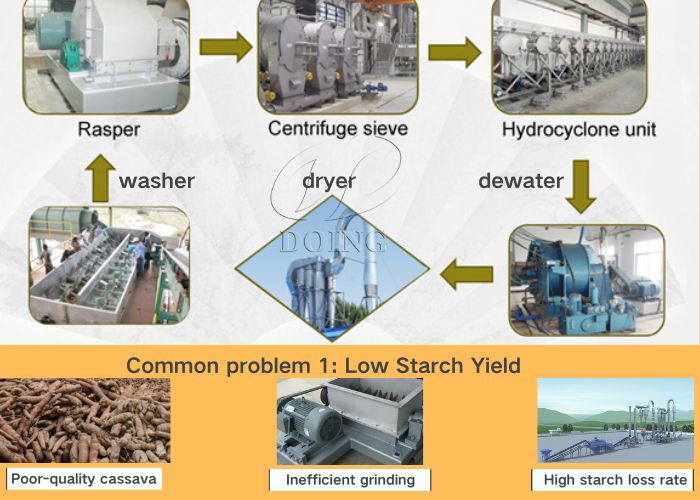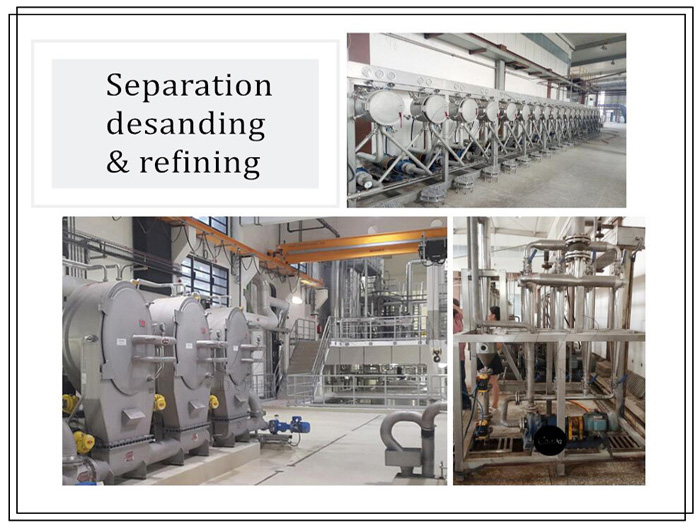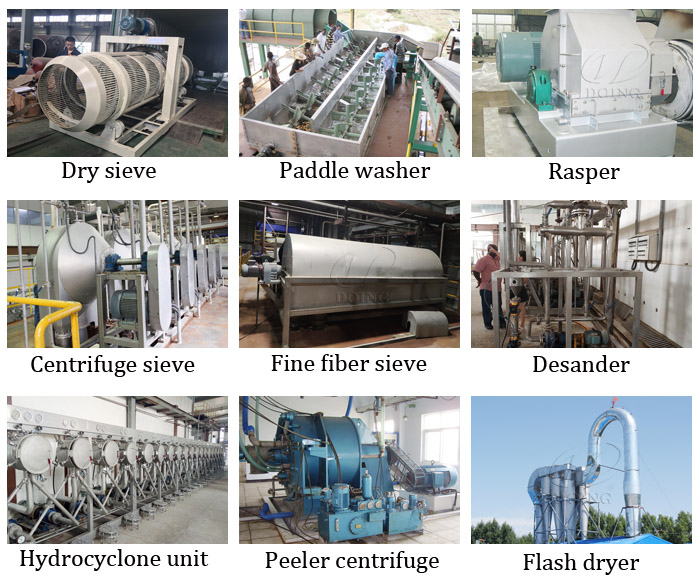Common Problems and Solutions During Cassava Starch Production
Cassava starch production is a complex process that spans from harvesting the roots to packaging the final product. Although the process is well-established, various challenges can arise, such as low cassava starch yield, equipment inefficiency, and quality inconsistencies. This article aims to outline the common problems faced during cassava starch production and provide practical solutions to optimize yield, quality, and profitability.
Common problem 1: Low Starch Yield
In cassava starch production, cassava starch yield is one of the most concerned issues for processors. Low starch yield is also a common problem in cassava starch production. The following is an analysis of the causes and solutions to this common problem.
Causes:
1. Poor-quality cassava roots: Low starch content or fungal infections in the roots can significantly reduce the starch yield.
2. Inefficient grinding equipment: If the equipment used for grinding is not effective, it may not release the starch sufficiently.
3. High cassava starch loss rate: Separation and purification steps are necessary in cassava starch production, which will lead to a high cassava starch loss rate.
Solutions:
1. Select high-starch cassava varieties: Choosing cassava varieties with a higher starch content can directly improve the yield.
2. Upgrade grinding machines: Equip with sharp blades and high-speed rollers (e.g., raspers from Henan Jinrui achieving ≥95% starch release) to enhance the cassava starch yield during the production.
3. Optimize water usage: During the extraction process, optimize water usage to minimize starch loss. For example, the cassava starch separation and extraction equipment designed by Henan Jinrui uses a multi-stage recovery device, which greatly solves the problem of low starch yield in the cassava starch production.
 Causes analysis about low cassava starch yield
Causes analysis about low cassava starch yield
Common problem 2: Browning of Starch
Starch whiteness is one of the key factors in determining whether cassava starch is of good quality. Why does starch turn brown during cassava starch production and what are the solutions? Henan Jinrui will answer this common problem for you.
Causes:
1. Enzymatic oxidation: Polyphenol oxidase activity in damaged roots can lead to enzymatic oxidation.
2. Prolonged exposure to air: During cassava starch production, if the roots are exposed to air for too long, it can cause discoloration.
3. Contamination with soil or mold: Contaminants such as soil or mold can affect the color of the starch.
Solutions:
1. Process roots promptly: Process the roots within 24–48 hours of harvest to prevent enzymatic browning.
2. Add antioxidants: Add sulfites or citric acid (0.1–0.3%) during washing to inhibit oxidation.
3. Use closed systems: Implement closed systems for grinding and washing to reduce air exposure.
Common problem 3: High Fiber Content in Starch
High-quality cassava starch has a relatively low fiber content. During the cassava starch production process, how to reduce the fiber content in starch? For this common problem, Henan Jinrui has provided cause analysis and solutions.
 Cassava starch processing equipment for fiber separation
Cassava starch processing equipment for fiber separation
Causes:
1. Incomplete separation of fibers: During cassava starch production, if fibers are not separated completely, it can result in high fiber content in the starch.
2. Overloading of hydrocyclones stations: Overloading these equipment can affect their efficiency in removing fibers.
Solutions:
1. Install multi-stage sieving systems: Use multiple sieving system(e.g., 3–5 screens with 80–120 mesh). Advanced sieves like centrifuge sieves designed by Henan Jinrui, which can run more than 1100 times per minute, can separate fibers more effectively. The standard number of stages in a complete cassava starch production line is 4–5.
2. Adjust hydrocyclone pressure: Set the pressure at 0.3–0.5 MPa for optimal fiber removal during cassava starch production.
Common problem 4: Wastewater Pollution
In the production of cassava starch, wastewater pollution is also a common problem that plagues cassava starch processors. The following are feasible solutions provided by Henan Jinrui.
Causes:
1. Organic-rich wastewater: The wastewater from washing and extraction is rich in organic matter.
2. Lack of treatment facilities: Without proper treatment, this wastewater can cause pollution.
Solutions:
1. Construct biogas digesters: Convert cassava peels and wastewater into energy using biogas digesters.
2. Install aerobic treatment systems: Reduce COD/BOD levels before discharging the wastewater. Before setting up a cassava starch factory, it is important to check and understand the local requirements for wastewater treatment and the standards that need to be met for discharge.
 Complete making line for high quality cassava starch production
Complete making line for high quality cassava starch production
Common problem 5: Inconsistent Starch Quality
In the process of cassava starch production, inconsistent starch quality is a common problem. The quality requirements for high-quality cassava starch sold are very high. Next, Henan Jinrui will analyze the reasons for the uneven quality of cassava starch production process for you and provide you with solutions to help you maximize the benefits of cassava starch production.
Causes:
1. Variable root starch content: The starch content in the roots can vary, affecting the final product quality.
2. Poor process control: Issues such as uneven drying or pH fluctuations can lead to inconsistent starch quality.
Solutions:
1. Standardize raw material intake: Test the starch content of the roots and aim for a target of 25–30% starch.
2. Use pH controllers in washing tanks to maintain a pH of 6.5–7.0.
Implement PLC-controlled dryers to ensure uniform moisture content.
Addressing the common problems in cassava starch production requires a combination of technological upgrades, process optimization, and proactive maintenance. By implementing the solutions outlined in this article, producers can enhance the yield, quality, and profitability of their cassava starch operations. If you are interested in our cassava starch processing machines, we welcome you to visit our factory to discuss further. Henan Jinrui will service you wholeheartedly!
contact us
- Do you want to buy machine?
- Yes, I want to buy machine
- No, I want to learn more in advance.
- What is your raw material?
- Cassava
- Potato
- Sweet potato
- Others
- 2. What is the final product you want to produce?
- Garri
- Cassava flour
- Cassava starch
- Cassava chips
- Attiekie
- Bammy
- Others
- 3.What is your capacity plan?
- Small scale garri machine
- 1ton per day
- 2tons per day
- 3tons per day
- 10tons per day
- 20tons per day
- Others
- 3.What is your capacity plan?
- Small scale
- 5tons per day
- 10tons per day
- 20tons per day
- 50tons per day
- 100tons per day
- Others
- 3.What is your capacity plan?
- Small scale
- 5tons per day
- 10tons per day
- 20tons per day
- 50tons per day
- 100tons per day
- 200tons per day
- 300tons per day
- Others
- 3.What is your capacity plan?
- Small scale
- Middle type
- Large scale
- What is your capacity plan?
- Small scale
- 5tons per day
- 10tons per day
- 20tons per day
- 50tons per day
- 100tons per day
- 200tons per day
- 300tons per day
- Others

 Call us
Call us Chat online
Chat online

